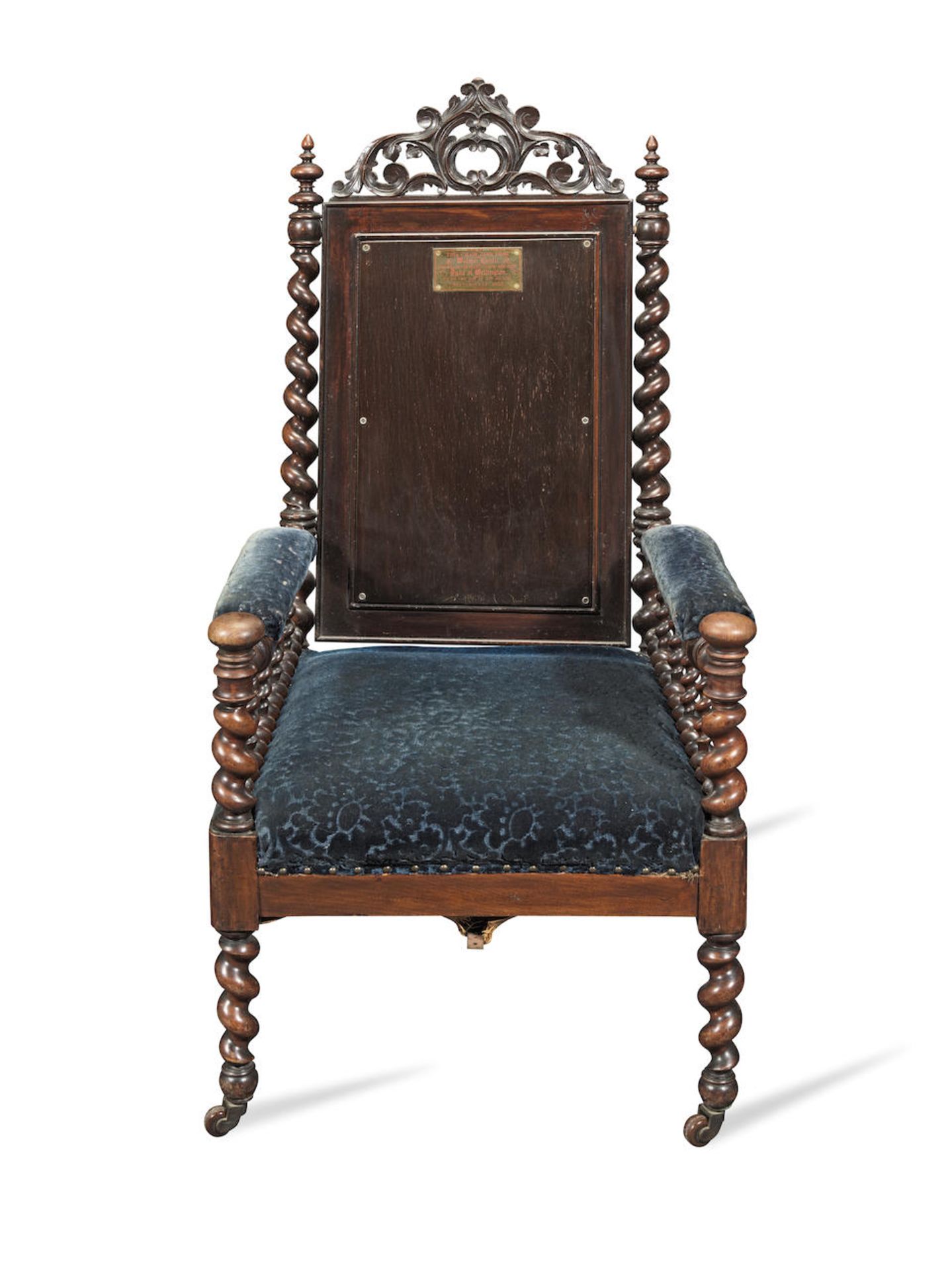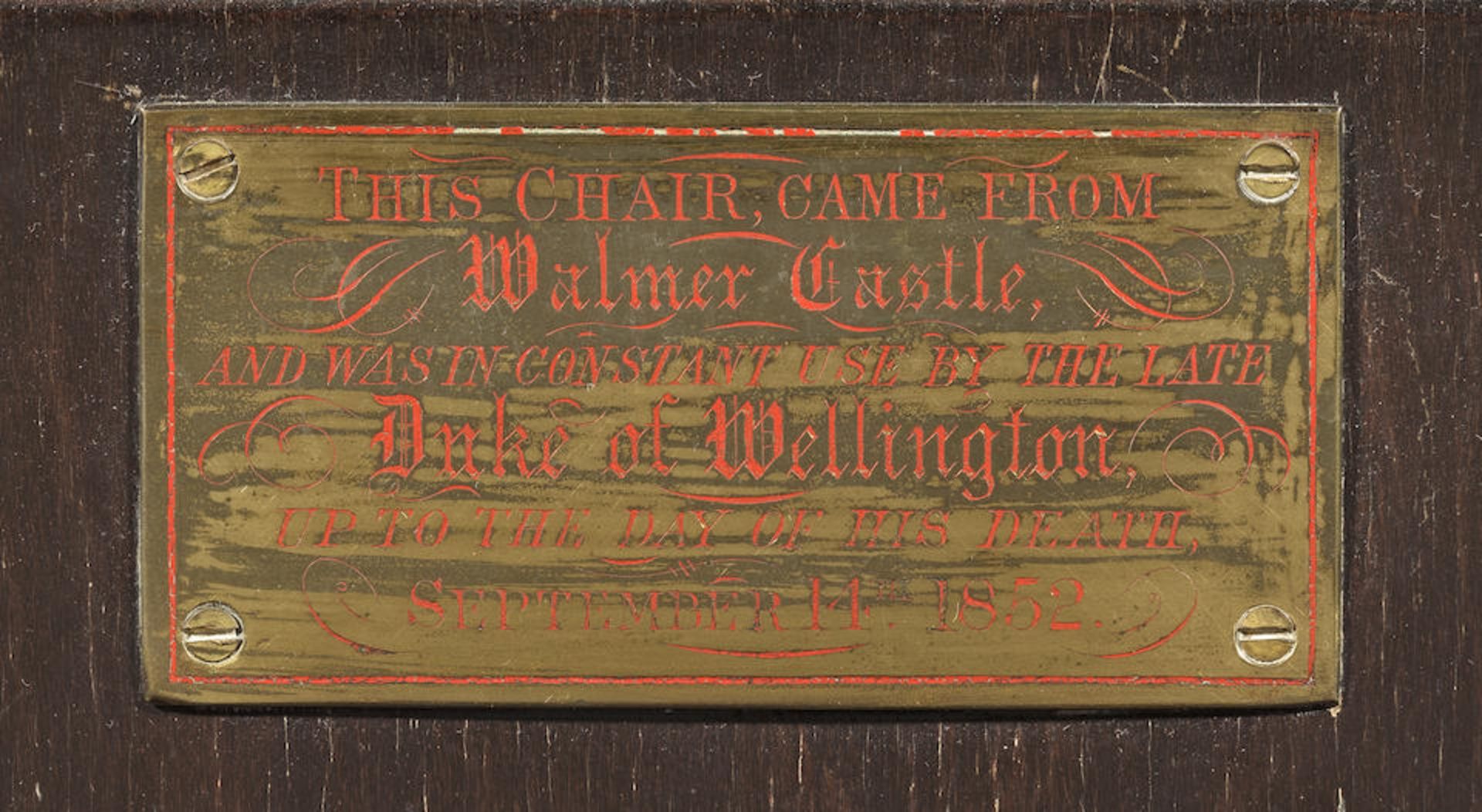169
OF HISTORICAL AND MILITARY INTEREST - A William IV 'Antiquarian' mahogany armchair purportedly u...
OF HISTORICAL AND MILITARY INTEREST - A William IV 'Antiquarian' mahogany armchair purportedly used, and probably owned, by the Duke of Wellington at Walmer Castle 1830-1840 With ring turned and spiral twist turned frames, arm terminals, spindles and front legs, the panelled back mounted with an engraved brass plaque which reads: 'This chair came from Walmer Castle, and was in constant use by the late, Duke of Wellington, up to the day of his death, September 14th, 1852', surmounted by a pierced C- and S-scrolled foliate cresting, with splayed rear legs, terminating in ceramic castors, approximately: 66cm wide x 72cm deep x 125cm high, (25 1/2in wide x 28in deep x 49in high) Footnotes: Provenance An engraved brass plaque mounted on the present lot states that it was used, and by extension almost certainly owned, by the Duke of Wellington whilst Britain's most famous military hero resided, during his latter years, at Walmer Castle until his death there in 1852. At some later point in time, this armchair came to form part of the furniture and furnishings of St. Vincent's Priory in Clifton, Bristol. Indeed, the chair appears in both an old black and white photograph (which appears to date to the 1960s) showing the interior of the upper ground floor reception room at St. Vincent's, as well as featuring in a near contemporary guide booklet about the house. Within the short booklet simply called Guide, it is stated that: 'The Priory was acquired in 1967 by the artist and philosopher George Melhuish', so clearly from that date onwards the offered lot belonged to Melhuish. The Duke of Wellington at Walmer Castle In his capacity as Lord Warden of the Cinque Ports, a position he held from 1829 until his death in 1852, every autumn during this period the Duke of Wellington would reside at Walmer Castle. And for two months following the great man's death at the age of 83, his body 'lay-in-state' at Walmer. During which time, the state funeral was being organised at St. Paul's Cathedral; where it was to eventually take place. Ultimately, the route through which the funeral procession passed was lined with over 1.5 million mourners. On 14 September 1852, the Duke of Wellington was found by his valet to be incapable of rising from his campaign bed, which was located in his bedroom at the castle. As a result of this fact, he was transferred to an armchair, but sadly went on to die later that same day. Interestingly, in 2015, this room was re-presented to the public, upon the 200th anniversary of the Battle of Waterloo, as closely as possible to how it appears depicted in a watercolour by an artist called Thomas Shotter Boys, which the latter had completed only a short while after the Duke's death. www.english-heritage.org.uk St. Vincent's Priory This charming, novel and idiosyncratic gothic revival house was evidently built in 1828. It is believed to have been constructed on top of caves traditionally held to have served at one point as a Christian sanctuary. However it remains unclear whether St. Vincent's Priory was originally conceived in the early 19th century to fulfil an ecclesiastical purpose, or rather be a kind of architectural folly. But it seems likely that a 'high church' figure, and certainly someone with a highly developed sense of Antiquarian aesthetic appreciation, was responsible for its creation. Arguably the most extraordinary element on the facade of this building are the presence of a number of stone figures. The row of lancet windows, which constitute the upper ground floor, are surmounted by four caryatids or sculptures seemingly holding up or supporting the overhanging shelf immediately above, which in turn indicates the base of the largest main central bay. These unusual figures appear to relate to several small carvings at the church of St. Mary Redcliffe. Higher up the facade, four smaller carved and painted wood caryatids of a more grotesque aspect crown the second floor bay. George Melhuish (1916-1985) George Melhuish was an expressionist painter, aesthete and philosopher who bought and moved into St. Vincent's Priory in 1967. This interesting modern British artist lived at the remarkable house in Bristol until his death in 1985. Not only did he house therein a collection of his own pictures along with some works of his modernist contemporaries, but during his residence Melhuish also oversaw major restoration and refurbishment to the interior of the house. Whilst Melhuish lived at St. Vincent's it is evident that such internal revitalisation was not matched by any corresponding operations to its exterior. However, it seems the painter even got involved in the aforesaid restoration process himself through his own work carried out on the frieze of the music room. The previously mentioned (probably 1970s?) guide booklet about St. Vincent's Priory, together with a couple of old photos of the building and two room interiors (probably 1960s?), along with a short book about George Melhuish, are available to view with this chair and will accompany the lot once it has sold. This lot is subject to the following lot symbols: TP TP For auctions held in Scotland: Lots will be moved to an offsite storage location (Constantine, Constantine House, North Caldeen Road, Coatbridge ML5 4EF, Scotland, UK) and will only be available for collection from this location at the date stated in the catalogue. Please refer to the catalogue for further information. For all other auctions: Lots will be moved to an offsite storage location (Cadogan Tate, Auction House Services, 241 Acton Lane, London NW10 7NP, UK) and will only be available for collection from this location at the date stated in the catalogue. Please note transfer and storage charges will apply to any lots not collected after 14 calendar days from the auction date. For further information on this lot please visit Bonhams.com For further information about this lot please visit the lot listing
OF HISTORICAL AND MILITARY INTEREST - A William IV 'Antiquarian' mahogany armchair purportedly used, and probably owned, by the Duke of Wellington at Walmer Castle 1830-1840 With ring turned and spiral twist turned frames, arm terminals, spindles and front legs, the panelled back mounted with an engraved brass plaque which reads: 'This chair came from Walmer Castle, and was in constant use by the late, Duke of Wellington, up to the day of his death, September 14th, 1852', surmounted by a pierced C- and S-scrolled foliate cresting, with splayed rear legs, terminating in ceramic castors, approximately: 66cm wide x 72cm deep x 125cm high, (25 1/2in wide x 28in deep x 49in high) Footnotes: Provenance An engraved brass plaque mounted on the present lot states that it was used, and by extension almost certainly owned, by the Duke of Wellington whilst Britain's most famous military hero resided, during his latter years, at Walmer Castle until his death there in 1852. At some later point in time, this armchair came to form part of the furniture and furnishings of St. Vincent's Priory in Clifton, Bristol. Indeed, the chair appears in both an old black and white photograph (which appears to date to the 1960s) showing the interior of the upper ground floor reception room at St. Vincent's, as well as featuring in a near contemporary guide booklet about the house. Within the short booklet simply called Guide, it is stated that: 'The Priory was acquired in 1967 by the artist and philosopher George Melhuish', so clearly from that date onwards the offered lot belonged to Melhuish. The Duke of Wellington at Walmer Castle In his capacity as Lord Warden of the Cinque Ports, a position he held from 1829 until his death in 1852, every autumn during this period the Duke of Wellington would reside at Walmer Castle. And for two months following the great man's death at the age of 83, his body 'lay-in-state' at Walmer. During which time, the state funeral was being organised at St. Paul's Cathedral; where it was to eventually take place. Ultimately, the route through which the funeral procession passed was lined with over 1.5 million mourners. On 14 September 1852, the Duke of Wellington was found by his valet to be incapable of rising from his campaign bed, which was located in his bedroom at the castle. As a result of this fact, he was transferred to an armchair, but sadly went on to die later that same day. Interestingly, in 2015, this room was re-presented to the public, upon the 200th anniversary of the Battle of Waterloo, as closely as possible to how it appears depicted in a watercolour by an artist called Thomas Shotter Boys, which the latter had completed only a short while after the Duke's death. www.english-heritage.org.uk St. Vincent's Priory This charming, novel and idiosyncratic gothic revival house was evidently built in 1828. It is believed to have been constructed on top of caves traditionally held to have served at one point as a Christian sanctuary. However it remains unclear whether St. Vincent's Priory was originally conceived in the early 19th century to fulfil an ecclesiastical purpose, or rather be a kind of architectural folly. But it seems likely that a 'high church' figure, and certainly someone with a highly developed sense of Antiquarian aesthetic appreciation, was responsible for its creation. Arguably the most extraordinary element on the facade of this building are the presence of a number of stone figures. The row of lancet windows, which constitute the upper ground floor, are surmounted by four caryatids or sculptures seemingly holding up or supporting the overhanging shelf immediately above, which in turn indicates the base of the largest main central bay. These unusual figures appear to relate to several small carvings at the church of St. Mary Redcliffe. Higher up the facade, four smaller carved and painted wood caryatids of a more grotesque aspect crown the second floor bay. George Melhuish (1916-1985) George Melhuish was an expressionist painter, aesthete and philosopher who bought and moved into St. Vincent's Priory in 1967. This interesting modern British artist lived at the remarkable house in Bristol until his death in 1985. Not only did he house therein a collection of his own pictures along with some works of his modernist contemporaries, but during his residence Melhuish also oversaw major restoration and refurbishment to the interior of the house. Whilst Melhuish lived at St. Vincent's it is evident that such internal revitalisation was not matched by any corresponding operations to its exterior. However, it seems the painter even got involved in the aforesaid restoration process himself through his own work carried out on the frieze of the music room. The previously mentioned (probably 1970s?) guide booklet about St. Vincent's Priory, together with a couple of old photos of the building and two room interiors (probably 1960s?), along with a short book about George Melhuish, are available to view with this chair and will accompany the lot once it has sold. This lot is subject to the following lot symbols: TP TP For auctions held in Scotland: Lots will be moved to an offsite storage location (Constantine, Constantine House, North Caldeen Road, Coatbridge ML5 4EF, Scotland, UK) and will only be available for collection from this location at the date stated in the catalogue. Please refer to the catalogue for further information. For all other auctions: Lots will be moved to an offsite storage location (Cadogan Tate, Auction House Services, 241 Acton Lane, London NW10 7NP, UK) and will only be available for collection from this location at the date stated in the catalogue. Please note transfer and storage charges will apply to any lots not collected after 14 calendar days from the auction date. For further information on this lot please visit Bonhams.com For further information about this lot please visit the lot listing










